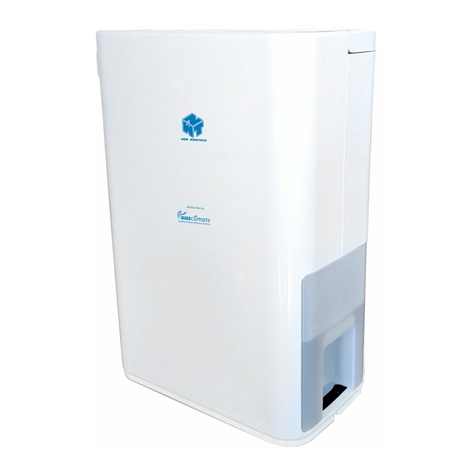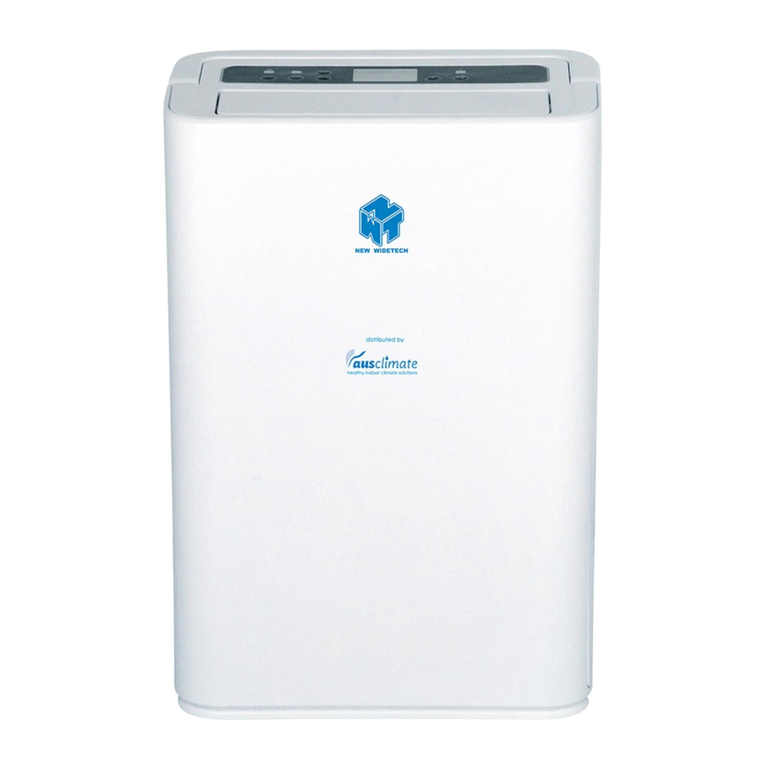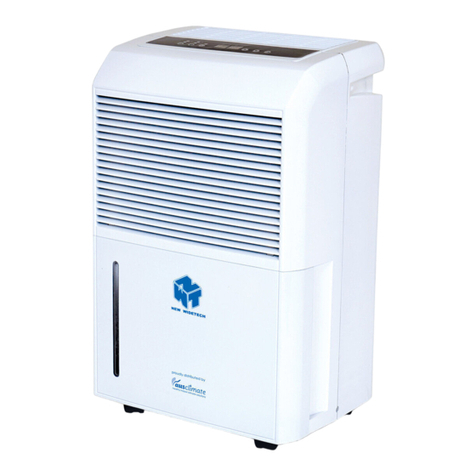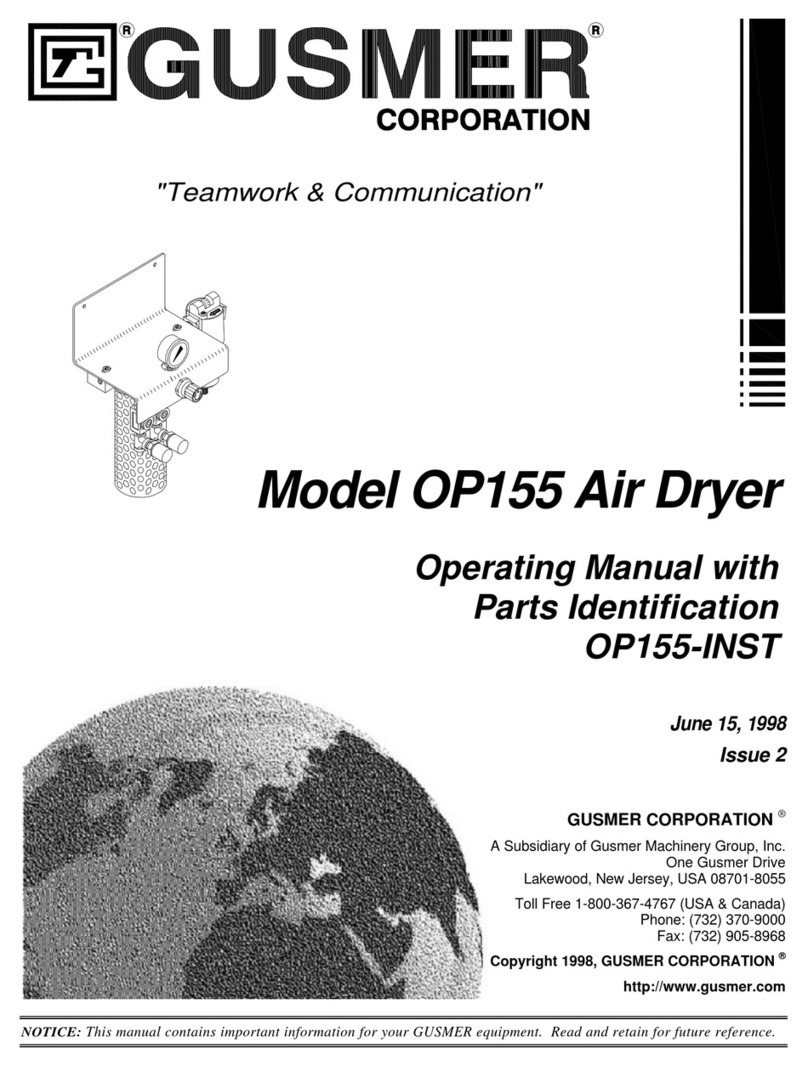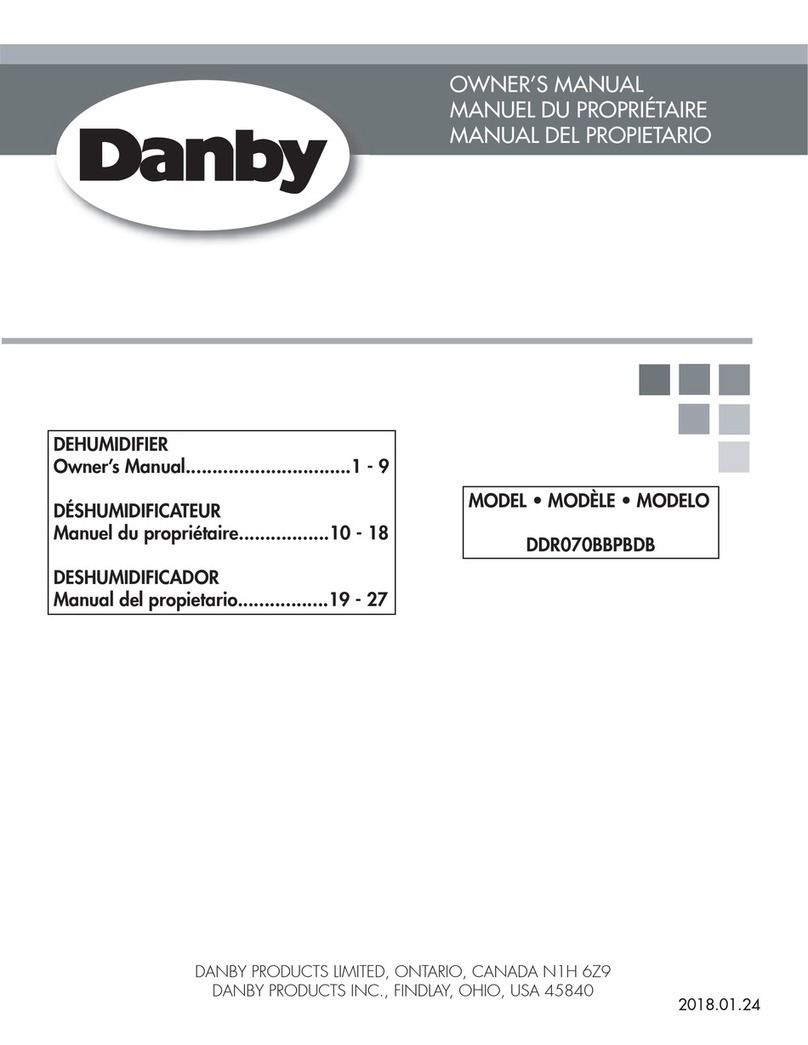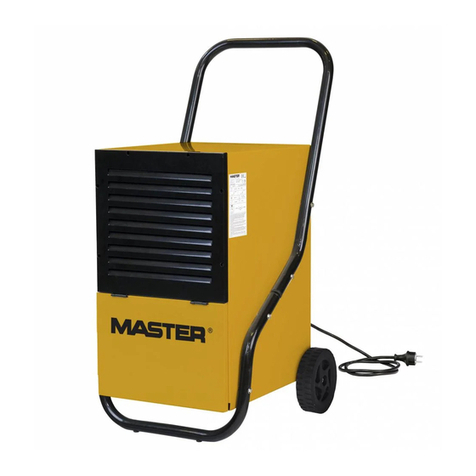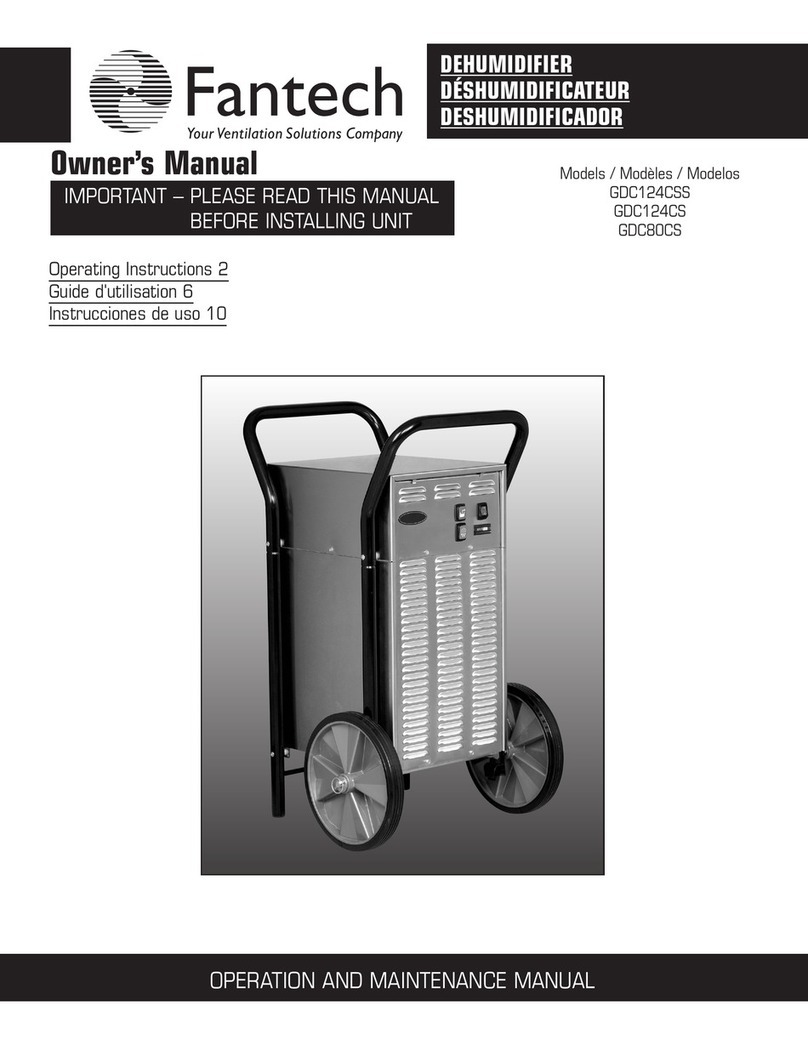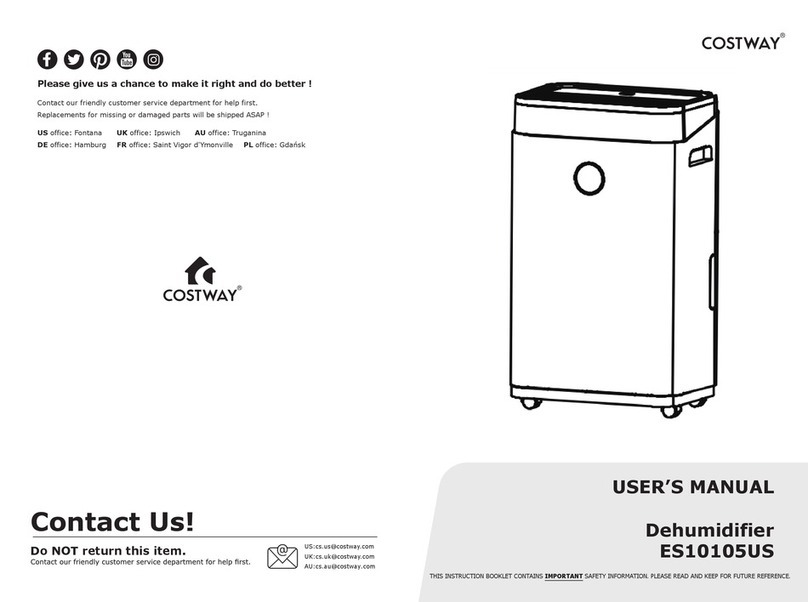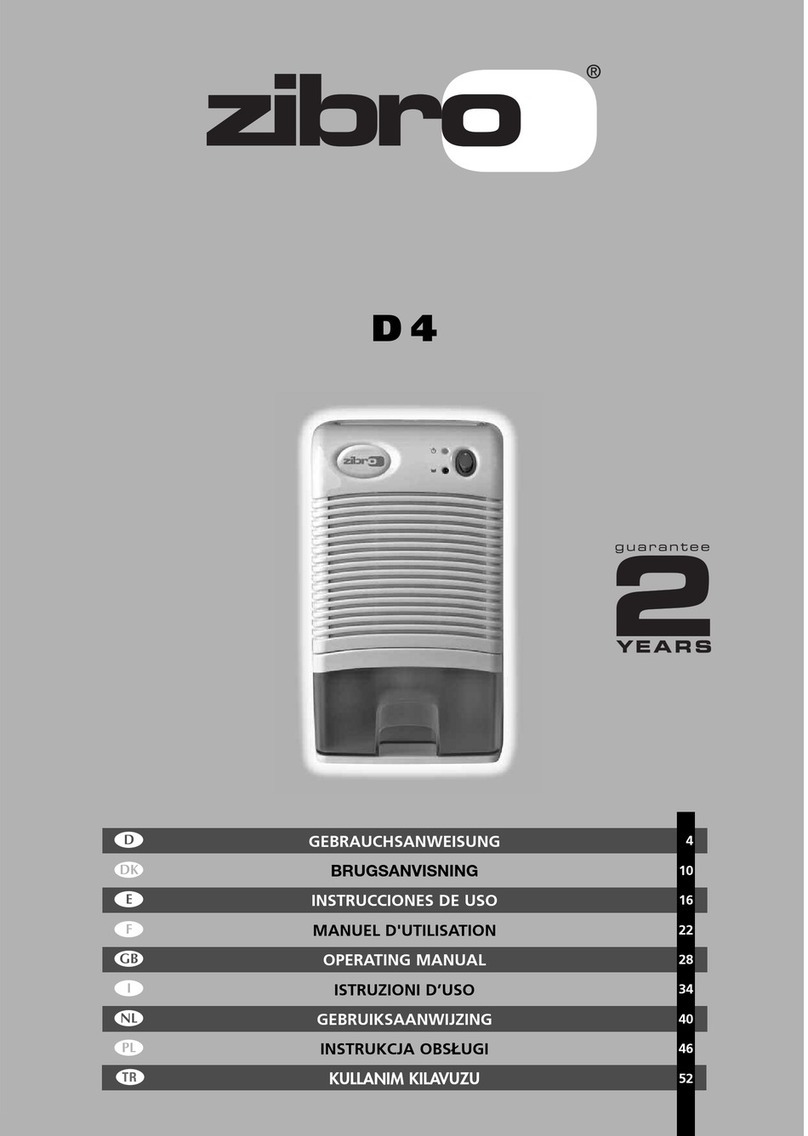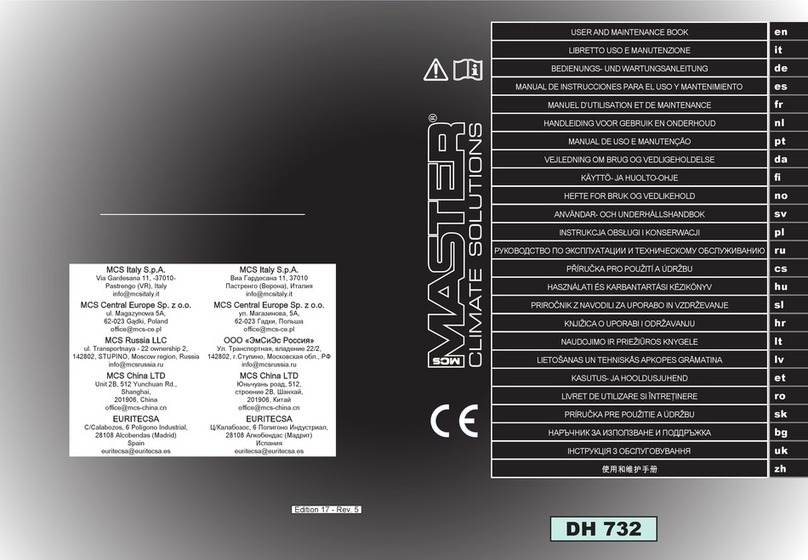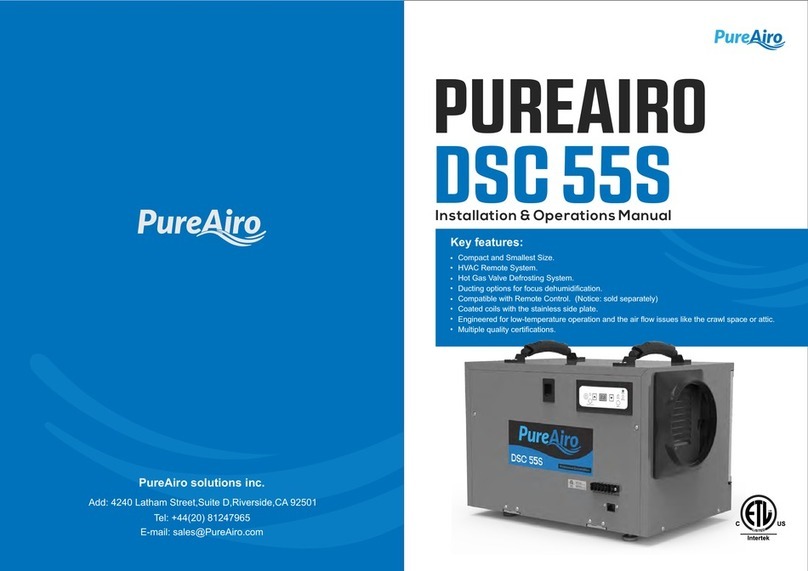AusClimate WDH-716DE User manual

WDH-716DE
WARNING · · · · · · · · · · · · · · · · · · · · · · · · · · 2-3
CAUTIONS · · · · · · · · · · · · · · · · · · · · · · · · · · · · · · · · 4-5
DESCRIPTION OF COMPONENTS /
FUNCTION EXPLANATION · · · · · · · · · · · · · · · · · · · · · · 6
OPERATING INSTRUCTIONS · · · · · · · · · · · · · · · · · · · · 7
CONTINUOUS DRAINAGE OPTIONS · · · · · · · · · · · · · · 8
MAINTENANCE / EMERGENCY · · · · · · · · · · · · · · · · · · 9
R290 AUTHORISED REPAIRER INSTRUCTIONS · · · 10-13
SPECIFICATIONS · · · · · · · · · · · · · · · · · · · · · LAST PAGE
· · · · · · ·

WARNING
• This appliance is not intended for use by persons (including children) with reduced physical,
sensory or mental capabilities, or lack of experience and knowledge, unless they have been
given supervision or instruction concerning use of the appliance by a person responsible for
their safety.
• Children shall be supervised to ensure they do not play with the appliance.
• If the supply cord is damaged, it must be replaced by the manufacturer, it's service agent or
similarly qualified persons in order to avoid a hazard.
• Only install and operate this appliance as outlined in this instruction manual. Use care at all
times when using this appliance.
• To avoid danger do not modify this appliance in any way.
• Electrical equipment and installations regulated by national legislation must be followed.
• It is essential that the appliance is connected to an efficient earth system checked by a
qualified electrician.
• The use of extension cables is not recommended.
• The air filter should be cleaned at a minimum of once every two weeks.
• Do not place the appliance near any heating appliance.
• The appliance should be transported upright. Any internal water should be emptied before
transporting.
• Do not turn the appliance on for at least one hour after transporting it.
• Flammable substances or pressurised containers (aerosol cans) should be kept a minimum of
50cms away from the appliance.
• The appliance should not be installed in rooms containing sulphur, gas or oil.
• Do not disconnect the appliance by pulling on the power cable; always disconnect the
appliance before any cleaning or maintenance is undertaken.
• Do not store anything on top of the appliance, especially heavy or hot objects.
• Repairs must only be undertaken by authorised service centres. Failure to comply may be
dangerous.
• Do not store the appliance covered with plastic bags.
• Remember the environment when disposing of the appliance packaging around the appliance.
• The appliance shall be stored in a well-ventilated area where the room size corresponds to the
room area as specified for operation. During storage keep ventilation openings clear of
obstruction.
• Cleaning and user maintenance shall not be made by children without supervision.
2

READ THE MANUAL CAREFULLY BEFORE USING THE APPLIANCE
(refer to the rating plate located at rear of the appliance for the type of refrigerant gas used).
Additional warnings for appliances with R290 refrigerant gas
WARNING
• R290 refrigerant gas complies with European environmental directives.
• This appliance contains approx. 0.086 kg of R290 refrigerant gas. The maximum charge
amount is 0.3 kg.
• The minimum rated airflow is 180 m³/h.
• Use only ingredients recommended by the manufacturer for defrosting or cleaning.
• Do not use the appliance in a room with continuously operating sources of ignition (eg. open
flames, an operating gas appliance or an operating electrical heater).
• A surface area greater than 4 m² is necessary for the installation, use and storage of the
appliance.
• Do not pierce or burn the appliance.
• Do not perforate any of the components in the refrigerant circuit.
• Refrigerant gas may be odourless.
• Use care when storing the appliance.
• Stagnation of possible leaks of refrigerant gas in unventilated rooms could lead to fire or an
explosion hazard if the refrigerant comes in contact with electric heaters, stoves or other
sources of ignition.
• Only persons authorised by an accredited agency certifying their competence to handle
refrigerants in compliance with sector legislation should work on refrigerant circuits.
• Maintenance and repairs requiring the assistance of other qualified persons must be carried
out under the supervision of specialists in the use of refrigerants.
3

Do not fold the power
cord as shown below.
Make sure the plug is
placed fully & firm into
the socket.
Do not use multiple
sockets as shown below.
Make sure the plug
is clean.
After turning the unit off,
please take plug out of the
socket.
Do not have wet hands
when connecting the
power plug.
If the power cord on this unit is damaged it must be replaced by the manufacturer,
it’s service agent or qualified persons in order to avoid a hazard.
CAUTIONS
CAUTIONS
Do not place anything
on top of the control
panel.
Do not place anything over
the air inlet or air outlet.
Do not let children play
with the unit or control
panel.
Do not wet the machine
or the control panel.
Keep flammable gas/oil
away from the machine.
Ask professionals to do
the service and repair.
4

CAUTIONS
Do not pull the power cord,
which may break and cause danger.
Do not use insect, oil or paint spray
around the machine. They might
cause damage to the plastic parts
or start a fire.
Do not place the machine on uneven
ground. This may cause shaking, noise
and leakage of water.
It is dangerous to put anything into the
machine.
Keep the machine away from any
type of heat sources.
5
Keep the unit 20cm away from the
wall to dissipate the heat properly.
Close all windows and doors to
assist with the efficiency of
removing moisture.

HUMIDITY SETTING
Setting humidity from 30%~80%
FAN SPEED
High / Low
TIMERS
Timer setting 1~12
hours.
Power control
On / Off
LCD DISPLAY
BUCKET FULL LAMP
STOP
%RH Room humidity
Room temperature
Display timer setting of auto switch on / off
The indicator is on when the defrost
function is in operation.
Bucket full indicator the machine will stop running.
Low fan speed
High fan speed
LCD display :
Water tank is full
when illuminated
DESCRIPTION OF COMPONENTS
FUNCTION EXPLANATION
6
CONTROL PANEL
OUTLET FOR
DEHUMIDIFIED
DRY AIR
DRAIN BUCKET
AIR FILTER
CONTINUOUS
DRAINAGE OUTLET
ROLLER CASTORS
MOIST AIR
INTAKE

7
OPERATING INSTRUCTIONS
Please use both hands to
carefully empty the water tank.
● Start Operation
1) Place the product in an upright position on a flat, steady,
stable, heat-resistant surface. Make sure there is nothing
flammable or heat sensitive within 100 cm (39 inches).
Operating the product in any other position could cause a
hazard.
2) Insert the plug into a suitable wall socket. The dehumidifier
is suitable for operation on an electricity supply having the
same voltage as that shown on its rating label.
3) Make sure the water tank is correctly located. (After
switching on the machine for the first time, if the "Bucket
Full" lamp illuminates, just pull out the water tank, check
the "float" lever is able to move freely, then return the water
tank to the correct position.)
● When Bucket Full Light Is On
When the water tank is full the machine will stop and the "Bucket Full" light
will illuminate. The water tank should be carefully removed from the
machine by sliding it outwards from the front of the machine and it should be
emptied. When the empty tank is replaced properly into the machine, the
machine will start up and run normally.
When operating in low temperatures the surface of the dehumidifier's coil may
accumulate ice and effect the efficiency of the dehumidifier. When this happens
the machine will go into periodic defrost mode automatically. This is quite normal.
Defrost icon will come on, the compressor will cease operating and the fan will
continue to operate until the ice has thawed. As soon as the ice has melted, the
compressor will restart and continue the dehumidifying process. Defrost time may
vary depending on room temperature and humidity.
DEFROST

8
Continuous drainage is an additional method of removing collected water from the dehumidifier.
Instead of manually emptying the water tank, the User may choose this method to allow the
water to bypass the water tank and flow directly from the dehumidifier via a drain hose.
The following steps are useful when there are good conditions for drainage near the
dehumidifier.
Drain hose Back of the unit
Drain hose
3. Connect the drain hose to the drainage outlet.
Drain cap
1. Prepare hose to drain out water.
The hose has inner diameter of 13mm.
2. Unscrew drain cap of the drainage outlet
and remove soft rubber cover.
CONTINUOUS DRAINAGE OPTIONS
Continuous drainage outlet
Soft cover
Drain cap
INSTALLING DRAINAGE HOSE
When using continuous drainage, the drain hose must be placed horizontally below the level
of the drainage hole. Avoid uneven ground and kinking the hose.

MAINTENANCE
If a problem occurs, switch off and unplug the unit immediately.
For all troubleshooting please contact Ausclimate (www.ausclimate.com.au) and for your
own safety do not disassemble the dehumidifier.
EMERGENCY
Air filter cleans the dust and impurities from the air which may hinder the dehumidifying
function, these should be regularly cleaned. The filter is located behind the rear grill and
should be pulled outwards from the top to remove. Clean with a vacuum cleaner or wash
it with clean water and dry with a dry cloth. Replace filter and continue to operate the
dehumidifier.
9

INSTRUCTION FOR REPAIRING APPLIANCES CONTAINING R 290
AUTHORISED PERSONS ONLY!
10
1. Checks to the area
Prior to beginning any authorised work on systems containing flammable refrigerants, safety checks
are necessary to ensure that the risk of ignition is minimised. The following precautions shall be
complied with prior to conducting work on the system.
2. Work procedure
Work shall be undertaken under a controlled procedure so as to minimise the risk of a flammable
gas or vapour being present while the work is being performed.
3. General work area
All maintenance staff and others working in the local area shall be instructed on the nature of work
being carried out. Work in confined spaces shall be avoided. The area around the workspace shall
be sectioned off. Ensure that the conditions within the area have been made safe by control of
flammable material.
4. Checking for presence of refrigerant
The area shall be checked with an appropriate refrigerant detector prior to and during work, to
ensure the technician is aware of potentially flammable atmospheres. Ensure that the leak detection
equipment being used is suitable for use with flammable refrigerants, i.e. nonsparking, adequately
sealed or intrinsically safe.
5. Presence of fire extinguisher
If any hot work is to be conducted on the refrigeration equipment or any associated parts,
appropriate fire extinguishing equipment shall be available on hand. Have a dry powder or CO2
fire extinguisher adjacent to the charging area.
6. No ignition sources
No person carrying out work in relation to a refrigeration system which involves exposing any
pipework that contains or has contained flammable refrigerant shall use any sources of ignition
in such a manner that is may lead to the risk of fire or explosion. All possible ignition sources,
including cigarette smoking, should be kept sufficiently far away from the site of installation,
repairing, removing and disposal, during which flammable refrigerant can possibly be released to
the surrounding space. Prior to work taking place, the area around the equipment is to be surveyed
to make sure that there are no flammable hazards or ignition risks. “No Smoking” signs shall be
displayed.
7. Ventilated area
Ensure that the area is in the open or that it is adequately ventilated before breaking into the system
or conducting any hot work. A degree of ventilation shall continue during the period that the work is
carried out. The ventilation should safely disperse and released refrigerant and preferably expel it
externally into the atmosphere.
8. Checks to the refrigerant equipment
Where electrical components are being changed, they shall be fit for the purpose and to the correct
specification. At all times, the manufacturer's maintenance and service guidelines shall be followed.
If in doubt consult the manufacturer's technical department for assistance.
The following checks shall be applied to installations using flammable refrigerants:
- the charge size is in accordance with the room size within which the refrigerant containing the
parts are installed;
- the ventilation machinery and outlets are operating adequately and are not obstructed;
9. Checks to electrical devices
Repair and maintenance to electrical components shall include initial safety checks and component
inspection procedures. If a fault exists that could compromise safety, then no electrical supply shall
be connected to the circuit until it is satisfactorily dealt with. If the fault cannot be corrected
immediately but it is necessary to continue operation, an adequate temporary solution shall be used.
This shall be reported to the owner of the equipment so all parties are advised.
Initial safety checks shall include:

INSTRUCTION FOR REPAIRING APPLIANCES CONTAINING R 290
AUTHORISED PERSONS ONLY!
- that capacitors are discharged; this shall be done in a safe manner to avoid possibility of
sparking.
- that there are no live electrical components and wiring are exposed while charging, recovering
or purging the system;
- that there is continuity of earth bonding.
10. Repairs to sealed components
During repairs to sealed components, all electrical supplies shall be disconnected from the
equipment being worked upon prior to any removal of sealed covers, etc. If it is absolutely
necessary to have an electrical supply to equipment during servicing, then a permanently operating
form of leak detection shall be located at the most critical point to warn of a potentially hazardous
situation. Particular attention shall be paid to the following to ensure that by working on electrical
components, the casing is not altered in such a way that the level of protection is affected. This
shall include damage to cables, excessive number of connections, terminals not made to original
specification, damage to seals, incorrect fitting of glands, etc.
Ensure that apparatus is mounted securely.
Ensure that seals or sealing materials have not degraded such that they no longer serve the
purpose of preventing the ingress of flammable atmospheres. Replacement parts shall be in
accordance with the manufacturer's specifications.
NOTE: use of silicon sealant may inhibit the effectiveness of some types of leak detection
equipment. Intrinsically safe components do not have to be isolated prior to working on them.
11. Repair to intrinsically safe components
Do not apply any permanent inductive or capacitance loads to the circuit without ensuring that this
will not exceed the permissible voltage and current permitted for the equipment in use. Intrinsically
safe components are the only types that can be worked on while live in the presence of a flammable
atmosphere. The test apparatus shall be at the correct rating. Replace components only with parts
specified by the manufacturer. Other parts may result in the ignition of refrigerant in the atmosphere
from a leak.
12. Cabling
Check that cabling will not be subject to wear, corrosion, excessive pressure, vibration, sharp edges
or any other adverse environmental effects. The check shall also take into account the effects of
aging or continual vibrations from sources such as compressors or fans.
13. Detection of flammable refrigerants
Under no circumstances shall potential sources of ignition be used in the searching for or detection
of refrigerant leaks. A halide torch (or any other detector using a naked flame) shall not be used.
14. Leak detection methods
The following leak detection methods are deemed acceptable for systems containing flammable
refrigerants.
Electronic leak detectors shall be used to detect flammable refrigerants, but the sensitivity may not
be adequate, or may need re-calibration. (Detection equipment shall be calibrated in a refrigerant-
free area). Ensure that the detector is not a potential source of ignition and is suitable for the
refrigerant used. Leak detection equipment shall be set at a percentage of the LFL of the refrigerant
and shall be calibrated to the refrigerant employed and the appropriate percentage of gas (25%
maximum) is confirmed.
Leak detection fluids are suitable for use with most refrigerants but the use of detergents containing
chlorine shall be avoided as the chlorine may react with the refrigerant and corrode the copper
pipe-work.
If a leak is suspected, all naked flames shall be removed/extinguished.
If a leakage of refrigerant is found which requires brazing, all of the refrigerant shall be recovered
from the system, or isolated (by means of shit off valves) in a part of the system remote from the
leak.
11

INSTRUCTION FOR REPAIRING APPLIANCES CONTAINING R 290
AUTHORISED PERSONS ONLY!
Oxygen free nitrogen (OFN) shall then be purged through the system both before and during the
brazing process.
15. Removal and evacuation
When breaking into the refrigerant circuit to make repairs – or for any other purpose – conventional
procedures shall be used. However, it is important that the best practise is followed since
flammability is a consideration. The following procedure shall be adhered to:
- remove refrigerant;
- purge the circuit with inert gas;
- evacuate;
- purge again with inert gas;
- open the circuit by cutting or brazing.
The refrigerant charge shall be recovered into the correct recovery cylinders. The system shall be
“flushed” with OFN to render the unit safe. This process may need to be repeated several times.
Compressed air or oxygen shall not be used for this task. Flushing shall be achieved by breaking
the vacuum in the system with OFN and continuing to fill until the working pressure is achieved,
then venting to atmosphere, and finally pulling down to a vacuum. This process shall be repeated
until no refrigerant is within the system. When the final OFN charge is used, the system shall be
vented down to atmospheric pressure to enable work to take place. This operation is absolutely vital
if brazing operations on the pipe-work are to take place. Ensure that the outlet for the vacuum pump
is not close to any ignition sources and there is ventilation available.
16. Charging procedures
In addition to conventional charging procedures, the following requirements shall be followed:
- Ensure that contamination of different refrigerants does not occur when using charging
equipment. Hoses or lines shall be as short as possible to minimise the amount of refrigerant
contained in them.
- Cylinders shall be kept upright.
- Ensure that the refrigeration system is earthed prior to charging the system with refrigerant.
- Label the system when charging is complete (if not already).
- Extreme care shall be taken to not overfill the refrigerant system.
Prior to recharging the system it shall be pressure tested with OFN. The system shall be leak tested
on completion of charging but prior to commissioning. A follow up leak test shall be carried out prior
to leaving the site.
17. Decommissioning
Before carrying out this procedure, it is essential that the technician is completely familiar with the
equipment and all its details. It is recommended good practice that all refrigerants are recovered
safely. Prior to the task being carried out, an oil and refrigerant sample shall be taken in case
analysis is required prior to re-use of reclaimed refrigerant. It is essential that electrical power is
available before the task is commenced.
a) Become familiar with the equipment and its operation.
b) Isolate system electrically.
c) Before attempting the procedure ensure that:
- Mechanical handling equipment is available, if required, for handling refrigerant cylinders;
- All personal protective equipment is available and being used correctly;
- The recovery process is supervised at all time by a competent person.
- Recovery equipment and cylinder confirm to the appropriate standards.
d) Pump down refrigerant system, if possible.
e) If a vacuum is not possible, make a manifold so that the refrigerant can be removed from
various parts of the system.
12

INSTRUCTION FOR REPAIRING APPLIANCES CONTAINING R 290
AUTHORISED PERSONS ONLY!
f) Make sure the cylinder is situated on the scales before recovery takes place.
g) Start the recovery machine and operate in accordance with manufacturer's instructions.
h) Do not overfill cylinders. (no more than 80% volume liquid charge).
i) Do not exceed the maximum working pressure of the cylinder, even temporarily.
j) When the cylinders have been filled correctly and the process completed, make sure that the
cylinders and the equipment are removed from site promptly and all isolation valves on the
equipment are closed off.
k) Recovered refrigerant shall not be charged into another refrigerant system unless it has been
cleaned and checked.
18. Labelling
Equipment shall be labelled stating that is has been de-commissioned and emptied of refrigerant.
The label shall be dated and signed. Ensure that there are labels on the equipment stating the
equipment contains flammable refrigerant.
19. Recovery
When removing refrigerant from a system, either for servicing or de-commissioning, it is
recommended good practice that all refrigerants are removed safely.
When transferring refrigerant into cylinders, ensure that only appropriate refrigerant recovery
cylinders are employed. Ensure that the correct number of cylinders for holding the total system
charge are available. All cylinders to be used are designated for the recovered refrigerant and
labelled for that refrigerant (i.e. special cylinders for the recovery of refrigerant). Cylinders shall be
complete with pressure relief valve and associated shut-off valves in good working order. Empty
recovery cylinders are evacuated and, if possible, cooled before recovery occurs.
The recovery equipment shall be in good working order with a set of instructions concerning the
equipment that is at hand and shall be suitable for the recovery of flammable refrigerants.
In addition, a set of calibrated weighing scales shall be available and in good working order. Hoses
shall be complete with leak-free disconnect couplings and in good condition. Before using the
recovery machine, check that it is in satisfactory working order, has been properly maintained and
that any associated electrical components are sealed to prevent ignition in the event of a refrigerant
release. Consult manufacturer if in doubt.
The recovered refrigerant shall be returned to the refrigerant supplier in the correct recovery cylinder,
and the relevant Waste Transfer Note arranged. Do not mix refrigerants in recovery units and
especially not in cylinders.
If compressors or compressor oils are to be removed, ensure that they have been evacuated to an
acceptable level to make certain that flammable refrigerant does not remain with the lubricant. The
evacuation process shall be carried out prior to returning the compressor to the suppliers. Only
electric heating to the compressor body shall be employed to accelerate this process. When oil is
drained from a system, it shall be carried out safely.
20. Transport of equipment containing flammable refrigerants
Compliance with transport regulations
21. Discarded appliances supplies flammable refrigerants
See national regulations
22. Storage of equipment/appliances
The storage of equipment should be in accordance with the manufacturer's instructions.
23. Storage of packed (unsold) equipment
Storage package protection should be constructed such that mechanical damage to the equipment
inside the package will not cause a leak of the refrigerant charge. The maximum number of pieces
of equipment permitted to be stored together will be determined by local regulations.
24. Marking equipment using signs
See local regulations.
13

Waste electrical products should not be disposed of with household waste.
Please recycle where facilities exist. Check your local authority of retailer for recycling advice.
SPECIFICATIONS
14
WDH-716DE
420 W
20
362 x 582 x 270 mm
13 kg
SAA approval
0.086 kg
Certificate No.: TUV-025466-EA
Table of contents
Other AusClimate Dehumidifier manuals
Popular Dehumidifier manuals by other brands

Albion
Albion ARCTUS FENJA 25 user manual

PoolPak
PoolPak ComPak AW Series Installation, operation and maintenance
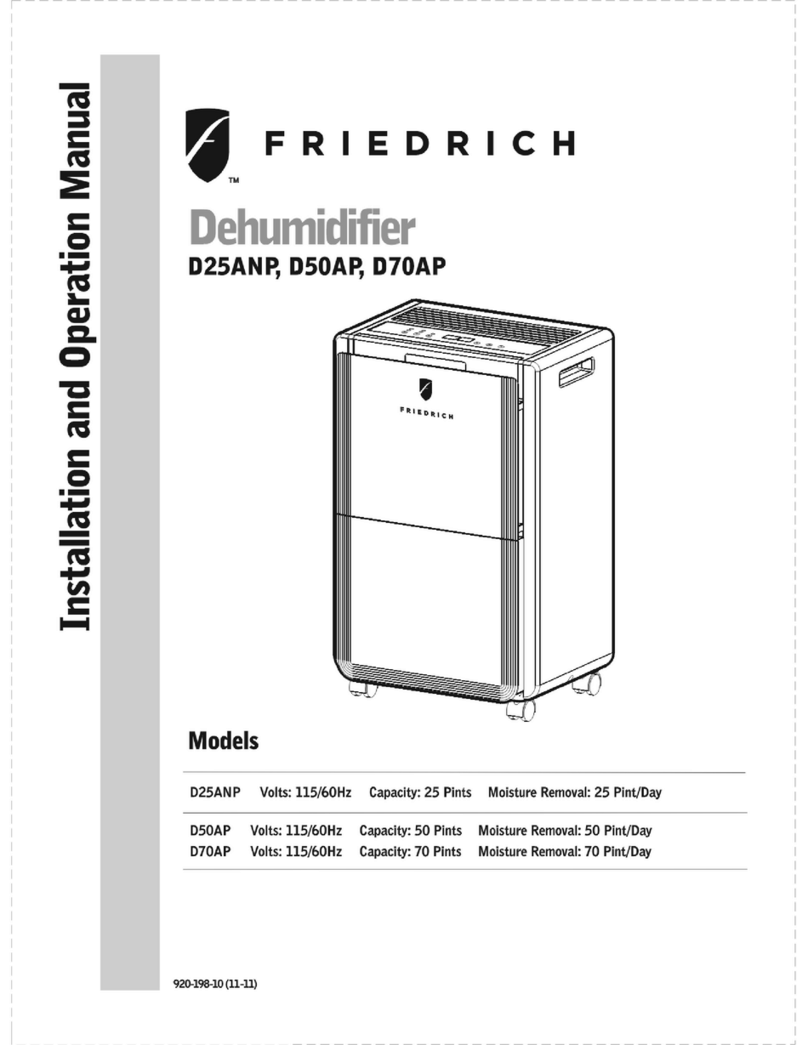
Friedrich
Friedrich D25ANP Installation and operation manual
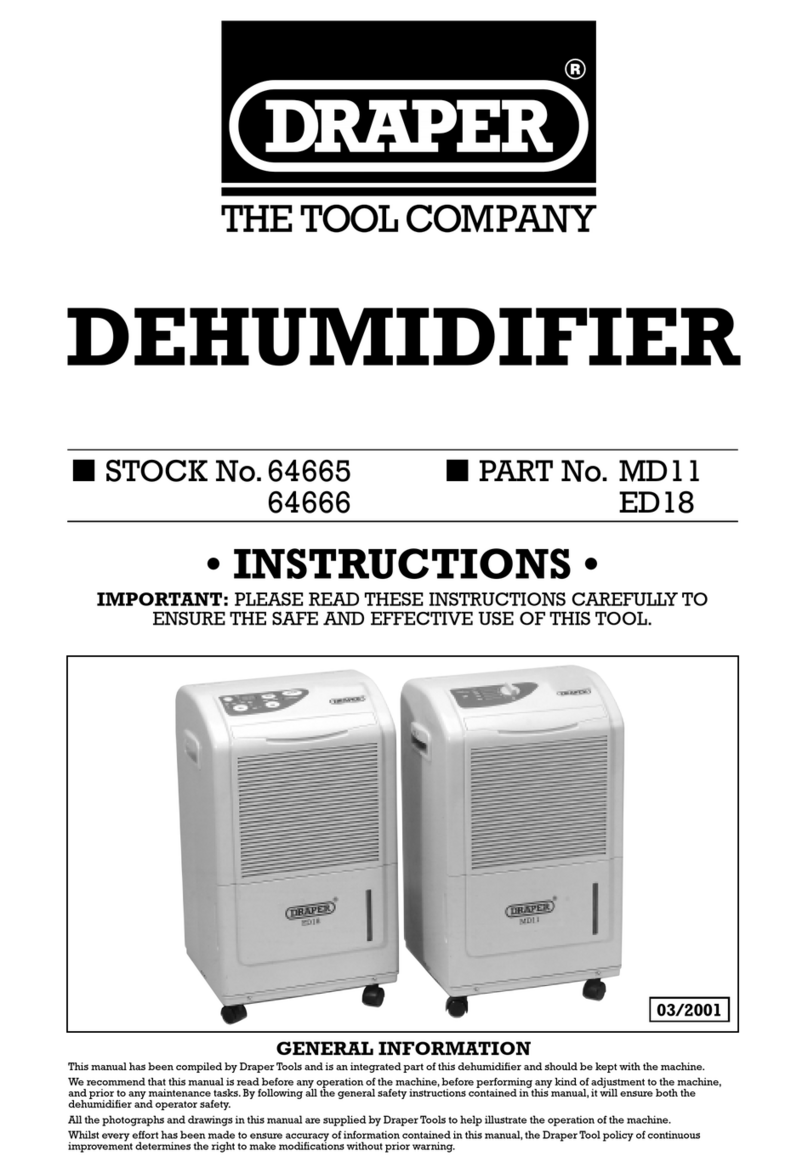
Draper
Draper DEHUMIDIFIER instructions

Mitsubishi Electric
Mitsubishi Electric MJ-E16AX-H instruction manual
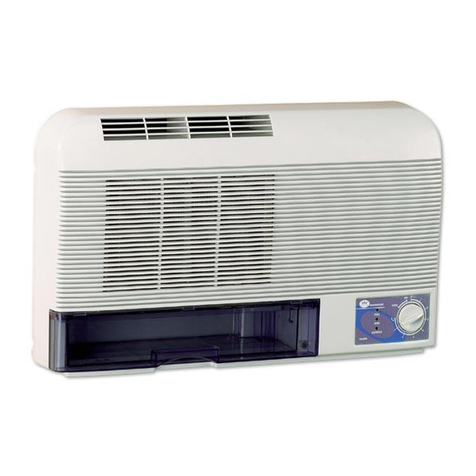
Prem-I-Air
Prem-I-Air DR102TB user manual
